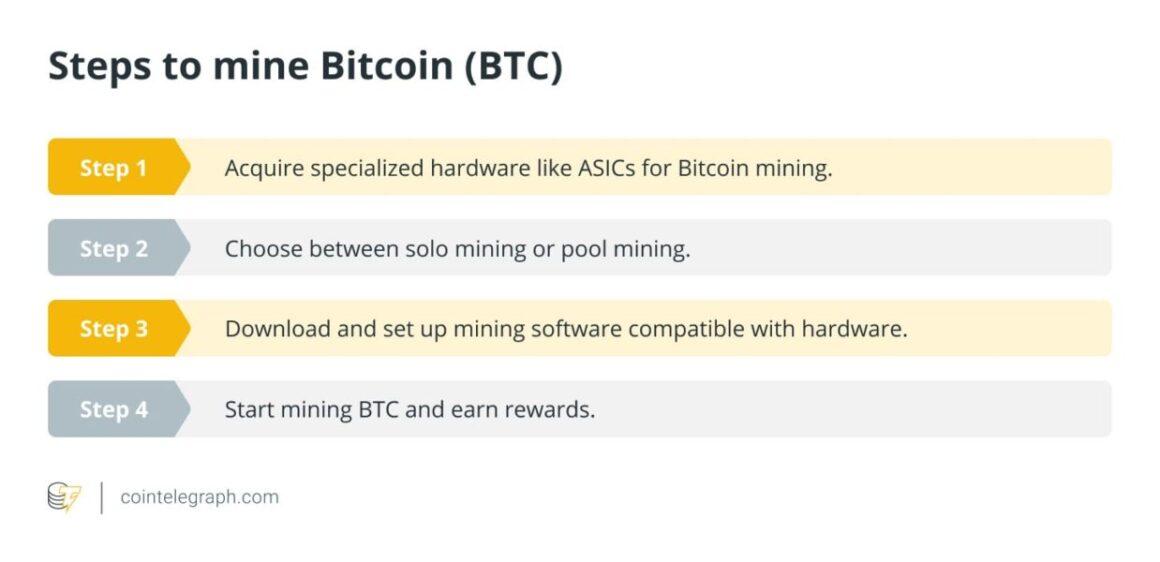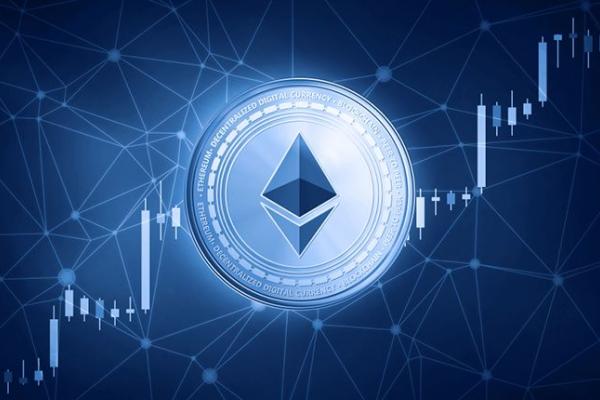What is Bitcoin mining?
Bitcoin mining is the process used to validate transactions on the network and introduce new Bitcoin into circulation.
As of July 2024, around 19.5 million Bitcoin were in circulation. However, the cryptocurrency is programmed to have a total supply of 21 million coins, with the remaining 1.5 million Bitcoin yet to enter into circulation. Users known as “miners” use powerful computers to solve complex mathematical problems and “mine” new Bitcoin in a process called Bitcoin mining.
When someone transacts on the Bitcoin network, their transaction is placed in a block. Once the block is full, it must be validated before being added to the blockchain. The process is similar to filling up a cart at a store and having a cashier check and validate your items at the checkout. You can fill up your cart freely, but once it is full, the store needs to check every item to ensure you’re not stealing.
Bitcoin mining is like a digital treasure hunt. Equipped with powerful computers, miners search for a 64-digit hexadecimal code known as a hash, which represents a block of transactions. Miners find this code through a process called hashing.
Hashing requires computer hardware to search through trillions of hashes (strings of numbers and letters) to find one that matches a block’s difficulty (called the target hash). Once miners find a block’s target hash, they can verify and confirm the block’s transactions. This process releases more Bitcoin into the network. It’s similar to playing a game where the rewards are locked away, creating a sense of value. Only those with the skill and know-how to unlock them can earn rewards.
Finding the target hash can take a long time. The amount of time varies based on many factors, such as the current Bitcoin mining difficulty. A difficulty adjustment or change occurs every 2,016 blocks and raises or lowers based on the number of miners contributing to the network.
More miners mean a higher difficulty, while fewer miners mean a lower difficulty. It’s like searching for a treasure: it gets harder and harder as more people try to find it, keeping it scarce and adding inherent value.
Bitcoin’s creator, Satoshi Nakamoto, programmed the network to halve every 210,000 blocks (around every four years) to create digital scarcity. At this rate, Bitcoin won’t hit its 21 million cap until 2140.
At this point, miners will still earn Bitcoin block rewards through transaction fees but will no longer release new Bitcoin into the network.
How do miners mine Bitcoin?
Miners mine Bitcoin using a mining rig, which can be anything from a normal PC to a dedicated machine, as long as it can follow SHA-256 — Bitcoin’s mining algorithm.
SHA-256 is an encryption method that makes data hard to read without the proper tools. It scrambles data, such as a password, and outputs a really long code to represent it. The thing is, that code means nothing to those without the tools to decrypt it, making it fully secure.
Even with the proper tools, decrypting this algorithm takes time. Miners mine a new block every 10 minutes, and the network distributes Bitcoin to miners for their efforts. This release of Bitcoin is called a block reward. Miners also receive transaction fees based on the block’s size.
Before the Bitcoin halving in April 2024, the block reward was 6.25 BTC per block. The Bitcoin halving event reduced this reward to 3.125 BTC. Bitcoin’s creator, Satoshi Nakamoto, programmed the halving into Bitcoin’s code, designed to create digital scarcity and maintain the value of Bitcoin, dramatically affecting Bitcoin mining profitability.
With each halving, it becomes harder for miners to earn as much as they did before, which increases the scarcity and, ideally, the value of Bitcoin.
What’s the average time needed to mine a single Bitcoin?
The length of time it takes to mine 1 Bitcoin can vary due to the network’s built-in difficulty settings.
Each committed Bitcoin block releases 3.125 BTC. To answer the central question, it takes an average of 10 minutes to mine not just 1 but 3 Bitcoin, and that rate will fluctuate over time.
Just like finding a treasure chest can result in varying amounts of treasure. Similarly, because it requires so much computing power to mine a single block (known as the Bitcoin block time), it’s nearly impossible for one miner to earn the entire 3.125 BTC reward on their own.
A miner’s hardware will significantly impact how much BTC they will earn. For example, some miners have dozens, if not hundreds, of pieces of mining hardware in an attempt to increase their Bitcoin hashrate.
In that case, they will probably earn more Bitcoin per block than other miners with a lower hashrate. They’re like a pirate that brings hundreds of shovels to the expedition and expect a proportional share of the rewards.

Many miners join a mining pool to increase their Bitcoin mining speed. A mining pool is a group of miners who contribute their hashrate as one entity in hopes of finding a target hash. In doing so, miners earn rewards based on their hashrate contribution.
A mining pool operator distributes Bitcoin mining rewards, though often at a fee, and miners can contribute to different types of Bitcoin mining pools.
Different Bitcoin mining pools
Proportional
A proportional mining pool distributes rewards based on a miner’s hashrate contribution. They can also earn additional rewards through transaction fees. It’s the pirate bringing hundreds of shovels to an expedition example mentioned earlier.
Pay per last N groups
Pay per last N groups mining pools distribute miners into shifts and pay them out based on their time on “shift.” A shift is a set period in which the miner contributes to the mining pool. This is like pirates working in shifts, with those working longer shifts getting more of the pay.
Pay-per-share
Pay-per-share pools provide miners with a fixed income, expecting them to contribute a certain amount of their hashrate daily. While this is a stable way to mine Bitcoin, it removes a miner’s ability to earn transaction fees. This is similar to every pirate in the expedition being expected to hit a daily quota. While no one can work overtime, they can expect consistent work and reliable income.
Which hardware optimizes Bitcoin mining speed?
In Bitcoin mining, an ASIC is the most efficient hardware because it’s specifically designed for the task. It offers significantly faster and more effective performance than CPUs and GPUs.
Imagine yourself attempting to locate the best seats in a huge, packed stadium. There are two ways to do it: either go over each row and section individually or utilize an extremely advanced drone to swiftly scan the entire stadium and identify the finest places.
In the world of Bitcoin mining, finding new blocks is like looking for the finest seats — you have to be extremely quick and effective in your “search.” This is where hardware becomes relevant:
- Central processing unit (CPU): Consider the CPU your standard search-and-find method. It’s similar to going over every row in the stadium manually. It’s not the fastest way to mine Bitcoin, but it does the job.
- Graphics processing unit (GPU): Now, let’s upgrade to a faster drone that can do many tasks at once. Similar to this drone, GPUs are far more capable than CPUs in handling the complex computations required for mining. They can find those ideal seats more quickly by simultaneously searching several rows.
- Application-specific integrated circuit (ASIC): This is like having a highly customized drone made specifically for searching the stadium for the best seats available, and it uses state-of-the-art technology to accomplish the task quickly and effectively. Because ASICs are designed exclusively for Bitcoin mining, they outperform GPUs and CPUs in this task.
So, if you want to optimize your Bitcoin mining speed, going for an ASIC is like using the ultimate high-tech drone to find those perfect seats faster than anyone else.
How hard is it to solo mine Bitcoin?
Solo mining Bitcoin involves one miner competing with every other miner globally. This process is incredibly challenging, and miners often join together to combat the challenge.
Bitcoin’s proof-of-work (PoW) consensus protocol makes mining a natural competition. The chances of a solo miner beating the rest of the world to a block’s target hash are nearly zero — no matter their mining rigs’ power or choice of Bitcoin mining software.
A solo miner is like a single pirate setting out on their own, while most pirates have banded together to find treasure. The group can rely on each other and has a better chance of finding the treasure, but the solo pirate, if successful, gets to keep all the rewards.
In Bitcoin’s early days, the time to mine one Bitcoin was relatively low due to a few miners. Block rewards were also much higher, with miners earning dozens of Bitcoin per block. However, Bitcoin was worth less than $1 back then, so the reward was proportionally fair.
Presently, solo miners join cryptocurrency mining pools to increase their chances of earning rewards via the Bitcoin mining process. Potential miners without a powerful mining rig also join a cloud mining service to save on the initial cost of Bitcoin mining equipment.
Cloud mining services consist of miners leasing out their hash power via the cloud and asking users to pay for a share of it. As a result, the miners offload some energy consumption costs to paying users. In return, paying users earn block rewards based on their share of hash power.
Source: https://cointelegraph.com/explained/how-long-does-it-take-to-mine-1-bitcoin



